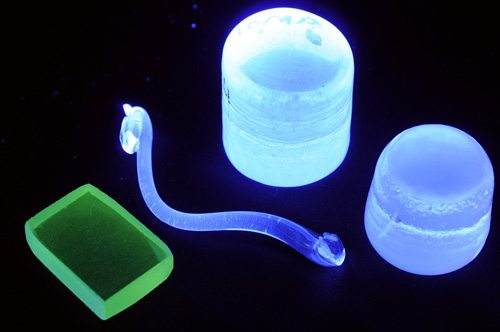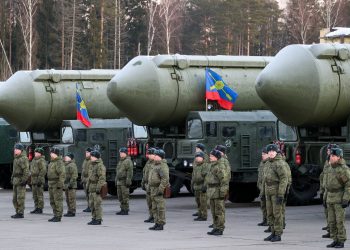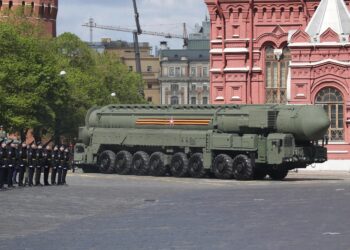Among terrorism scenarios that raise the most concern are attacks involving nuclear devices or materials. For that reason, technology that can effectively detect smuggled radioactive materials is considered vital to U.S. security.
To support the nation’s nuclear-surveillance capabilities, researchers at the Georgia Tech Research Institute (GTRI) are developing ways to enhance the radiation-detection devices used at ports, border crossings, airports and elsewhere. The aim is to create technologies that will increase the effectiveness and reliability of detectors in the field, while also reducing cost. The work is co-sponsored by the Domestic Nuclear Defense Office of the Department of Homeland Security and by the National Science Foundation.
“U.S. security personnel have to be on guard against two types of nuclear attack – true nuclear bombs, and devices that seek to harm people by dispersing radioactive material,” said Bernd Kahn, a researcher who is principal investigator on the project. “Both of these threats can be successfully detected by the right technology.”
The GTRI team, led by co-principal investigator Brent Wagner, is utilizing novel materials and nanotechnology techniques to produce improved radiation detection. The researchers have developed the Nano-photonic Composite Scintillation Detector, a prototype that combines rare-earth elements and other materials at the nanoscale for improved sensitivity, accuracy and robustness.
Details of the research were presented at the SPIE Defense, Security, and Sensing Conference held in Baltimore, MD.
Scintillation detectors and solid-state detectors are two common types of radiation detectors, Wagner explained. A scintillation detector commonly employs a single crystal of sodium iodide or a similar material, while a solid-state detector is based on semiconducting materials such as germanium.
Both technologies are able to detect gamma rays and subatomic particles emitted by nuclear material. When gamma rays or particles strike a scintillation detector, they create light flashes that are converted to electrical pulses to help identify the radiation at hand. In a solid-state detector, incoming gamma rays or particles register directly as electrical pulses.
“Each reaction to a gamma ray takes a very short time – a fraction of a microsecond,” Wagner said. “By looking at the number and the intensity of the pulses, along with other factors, we can make informed judgments about the type of radioactive material we’re dealing with.”
But both approaches have drawbacks. A scintillation detector requires a large crystal grown from sodium iodide or other materials. Such crystals are typically fragile, cumbersome, difficult to produce and extremely vulnerable to humidity.
A germanium-based solid-state detector offers better identification of different kinds of nuclear materials. But high-purity single-crystal germanium is difficult to make in a large volume; the result is less-sensitive devices with reduced ability to detect radiation at a distance. Moreover, germanium must be kept extremely cold – 200 degrees below zero Celsius – to function properly, which poses problems for use in the field.
The Nanoscale Advantage
To address these problems, the GTRI team has been investigating a wide variety of alternative materials and methodologies. After selecting the scintillation approach over solid-state, the researchers developed a composite material – composed of nanoparticles of rare-earth elements, halides and oxides – capable of creating light.
“A nanopowder can be much easier to make, because you don’t have to worry about producing a single large crystal that has zero imperfections,” Wagner said.
A scintillator crystal must be transparent to light, he explained, a quality that’s key to its ability to detect radiation. A perfect crystal uniformly converts incoming energy from gamma rays to flashes of light. A photo-multiplier then amplifies these flashes of light so they can be accurately measured to provide information about radioactivity.
However, when a transparent material – such as crystal or glass – is ground into smaller pieces, its transparency disappears. As a result, a mixture of particles in a transparent glass would scatter the luminescence created by incoming gamma rays. That scattered light can’t reach the photo-multiplier in a uniform manner, and the resulting readings are badly skewed.
To overcome this issue, the GTRI team reduced the particles to the nanoscale. When a nanopowder reaches particle sizes of 20 nanometers or less, scattering effects fade because the particles are now significantly smaller than the wavelength of incoming gamma rays.
“Think of it as a big ocean wave coming in,” Wagner said. “That wave would definitely interact with a large boat, but something the size of a beach ball doesn’t affect it.”
Rare Earths and Silica
At first the team worked on dispersing radiation-sensitive crystalline nanoparticles in a plastic matrix. But they encountered problems with distributing the nanopowder uniformly enough in the matrix to achieve sufficiently accurate radiation readings.
More recently, the researchers have investigated a parallel path using glass rather than plastic as a matrix material, combining gadolinium and cerium bromide with silica and alumina.
Kahn explained that gadolinium or a similar material is essential to scintillation-type particle detection because of its role as an absorber. But in this case, when an incoming gamma ray is absorbed in gadolinium, the energy is not efficiently emitted in the form of luminescence.
Instead, the light emission role here falls to a second component – cerium. The gadolinium absorbs energy from an incoming gamma ray and transfers that energy to the cerium atom, which then acts as an efficient light emitter.
The researchers found that by heating gadolinium, cerium, silica and alumina and then cooling them from a molten mix to a solid monolith, they could successfully distribute the gadolinium and cerium in silica-based glasses. As the material cools, gadolinium and cerium precipitate out of the aluminosilicate solution and are distributed throughout the glass in a uniform manner. The resulting composite gives dependable readings when exposed to incoming gamma rays.
“We’re optimistic that we’ve identified a productive methodology for creating a material that could be effective in the field,” Wagner said. “We’re continuing to work on issues involving purity, uniformity and scaling, with the aim of producing a material that can be successfully tested and deployed.”










